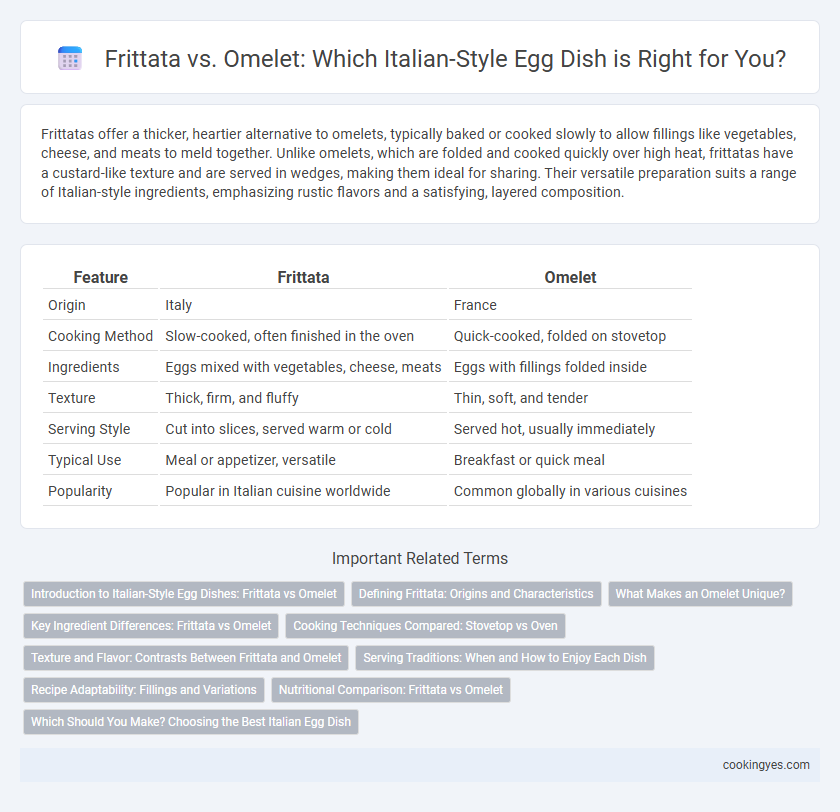Frittatas offer a thicker, heartier alternative to omelets, typically baked or cooked slowly to allow fillings like vegetables, cheese, and meats to meld together. Unlike omelets, which are folded and cooked quickly over high heat, frittatas have a custard-like texture and are served in wedges, making them ideal for sharing. Their versatile preparation suits a range of Italian-style ingredients, emphasizing rustic flavors and a satisfying, layered composition.
Table of Comparison
| Feature | Frittata | Omelet |
|---|---|---|
| Origin | Italy | France |
| Cooking Method | Slow-cooked, often finished in the oven | Quick-cooked, folded on stovetop |
| Ingredients | Eggs mixed with vegetables, cheese, meats | Eggs with fillings folded inside |
| Texture | Thick, firm, and fluffy | Thin, soft, and tender |
| Serving Style | Cut into slices, served warm or cold | Served hot, usually immediately |
| Typical Use | Meal or appetizer, versatile | Breakfast or quick meal |
| Popularity | Popular in Italian cuisine worldwide | Common globally in various cuisines |
Introduction to Italian-Style Egg Dishes: Frittata vs Omelet
Frittata, a traditional Italian-style egg dish, differs from an omelet by incorporating various ingredients like vegetables, cheeses, and meats mixed directly into the beaten eggs before cooking. Unlike the folded omelet, the frittata is cooked slowly over low heat and often finished in the oven, resulting in a thicker, more custard-like texture. This method creates a versatile dish ideal for serving multiple portions, making it a staple in Italian cuisine.
Defining Frittata: Origins and Characteristics
Frittata, a traditional Italian egg dish originating from Italy, is characterized by its thick, open-faced structure and multiple layers of ingredients such as vegetables, cheeses, and meats mixed directly into the beaten eggs. Unlike an omelet, which is typically folded and cooked quickly over high heat, a frittata is cooked slowly on low heat and often finished in the oven, resulting in a denser, more casserole-like texture. Key features of a frittata include its versatility as a hearty meal and its ability to incorporate diverse fillings throughout, making it distinct from the lighter, folded omelet style.
What Makes an Omelet Unique?
An omelet is unique for its quick cooking technique where beaten eggs are cooked rapidly over medium-high heat and then folded around fillings, creating a soft, tender texture inside. Unlike frittatas, which are finished in the oven or under a broiler, omelets rely solely on stovetop cooking, resulting in a light, slightly creamy interior. This method emphasizes delicate curds and precise timing, making omelets a classic Italian-style egg dish known for their versatility and elegant presentation.
Key Ingredient Differences: Frittata vs Omelet
Frittata primarily incorporates whole eggs mixed with a variety of ingredients such as vegetables, cheeses, and meats, which are combined and cooked slowly to create a thick, hearty dish. Omelets typically use beaten eggs cooked quickly, with fillings like cheese or vegetables folded inside just before serving, resulting in a lighter, fluffier texture. Key ingredient differences highlight frittatas' inclusion of pre-cooked or raw fillings evenly distributed, contrasting with omelets' filling added after partial cooking of eggs.
Cooking Techniques Compared: Stovetop vs Oven
Frittatas are typically started on the stovetop and finished in the oven, allowing for even cooking and a firm, sliceable texture. Omelets are cooked entirely on the stovetop, folded quickly to retain a soft, creamy interior. The oven's consistent heat in frittatas ensures thorough cooking without flipping, while omelets require constant stovetop attention for proper texture and doneness.
Texture and Flavor: Contrasts Between Frittata and Omelet
Frittata offers a denser, more custard-like texture due to slow cooking and finishing in the oven, whereas an omelet is lighter and fluffier from quick stovetop cooking. Flavor in frittata develops deeply as ingredients meld and caramelize during longer cooking times, while omelets retain distinct, fresh tastes of fillings with minimal browning. The unique preparation methods of frittata and omelet create contrasting sensory experiences that define these classic Italian-style egg dishes.
Serving Traditions: When and How to Enjoy Each Dish
Frittatas are traditionally served warm or at room temperature, often as a main meal for breakfast, lunch, or dinner in Italian households, showcasing a hearty blend of eggs, vegetables, and cheeses. Omelets, conversely, are typically enjoyed hot and freshly cooked, making them a swift and customizable option for breakfast or brunch. The frittata's dense, sliceable nature suits communal sharing, while the omelet's folded form lends itself to personal servings.
Recipe Adaptability: Fillings and Variations
Frittatas offer greater recipe adaptability with a wide range of fillings such as vegetables, cheeses, and meats mixed directly into the eggs before cooking, allowing even distribution of flavors. Unlike omelets, which typically have fillings folded inside, frittatas can incorporate ingredients like potatoes, spinach, and sausage in varied combinations, making them ideal for leftovers or diverse tastes. This flexibility supports Italian-style recipes that emphasize robust, layered textures and bold, harmonious flavors in a single dish.
Nutritional Comparison: Frittata vs Omelet
Frittatas typically contain more vegetables, cheese, and meats, resulting in higher protein and calorie content compared to omelets, which usually have simpler fillings and less volume. The cooking method of frittatas involves baking or slow-cooking, preserving more nutrients and offering a richer texture. Omelets provide a lighter option with fewer calories and fat, making them ideal for low-calorie, high-protein meals.
Which Should You Make? Choosing the Best Italian Egg Dish
Frittata offers a heartier, baked Italian egg dish featuring a mix of vegetables, cheeses, and meats, ideal for a satisfying meal that can be served warm or cold. Omelets provide a quicker, pan-cooked option with folded eggs and fillings, perfect for a lighter, customizable Italian-style breakfast or brunch. Choose frittata for a rustic, protein-rich dish with lasting flavor, or opt for an omelet when seeking a fast, delicate egg preparation.
Frittata vs Omelet for Italian-style egg dishes Infographic

 cookingyes.com
cookingyes.com